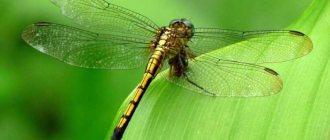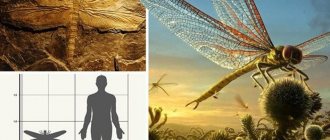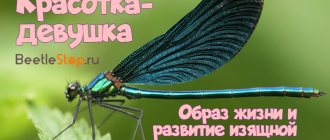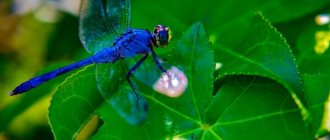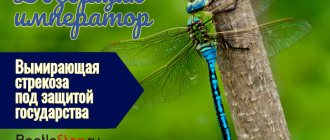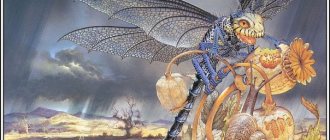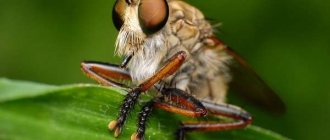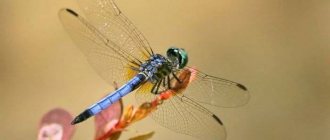Our largest dragonflies belong to this family. Their wingspan varies by species from 8 to 12 cm. The wing plates are uncolored, only Anaciaeshna isosceles has a golden-yellow spot at the base of each wing. On the territory of the European part of Russia there are 16 species of rockers of six genera: the patrolman (Apakh), aeskhna (Aeshna), caliaeshna (Caliaeshna), anatsyeshna (Anaciaeshna), brachytron (Brachytron) and hemianax (Hemianax). Among them there is a species that is found only on the Black Sea coast - Caliaeshna microstigma Schn., and a species that, on the contrary, is distributed exclusively in the northern regions and is very rare in the middle zone - the subarctic rocker Aeshna subarctica Walk. The most numerous dragonflies in our latitudes are the genus Aeshna.
Rocker larvae live in stagnant or weakly flowing water, preferring shallow reservoirs overgrown with aquatic plants. The body length of these aquatic predators reaches 6 cm in older ages, and they can cause serious damage to fish farming, damaging fish fry in fish ponds. Since the legs of rocker larvae are relatively weak, they are not adapted to a wandering lifestyle and sit in the water, attached to various objects and plants, like the larvae of homoptera dragonflies. However, they are also capable of quick throws after the victim, using the principle of jet propulsion when swimming. At the moment of throwing, the larva sharply ejects a stream of water from the hindgut, due to which its body receives a strong push, and the insect moves abruptly in the water. The larval stage of rockers lasts two years.
Read: Mole cricket family (Gryllotalpidae)
Dragonflies of the genus Anax are larger than other rockers. Only two species live in the European part of Russia. One, the watchman Parthenope Anaxparthenope Selys, is tied to the southern regions, the other, the watchman-emperor Anax imperator, is more widespread. The watchman Parthenope is a striking example of the romantic attitude of researchers towards beautiful insects. They are often given amazing names, in particular, like this species, which have mythological roots. This dragonfly is named after the ancient Greek siren Partenope, the site of whose death today is Naples, formerly called Partenopeia.
Structure
The dragonfly, the structure of which we are considering in this material, has a long and very thin body.
It, in turn, is connected to the cephalothorax. On the dragonfly’s body we can see three pairs of legs and two pairs of wings. It is also important to note that the wings are transparent, they can have the same size and shape, or different. We will talk about this in more detail when we consider the types
The dragonfly, whose structure can vary by species, can belong to one of two main groups:
As you might guess, the first group includes individuals that have wings of equal length and shape, while others have the opposite (one pair can be very different from the other). On the dragonfly's head we can clearly distinguish large eyes and antennae. A little more about the senses. The eyes of these insects are complex. They can be divided into two sections:
- the top one, responsible for object recognition;
- the lower one, responsible for color recognition.
You've probably noticed that the transparent wings of dragonflies have veins along their entire length, and at their tips there are spots darker than the color of the wings themselves. This device helps avoid wing fractures by reducing vibration during flights.
Remember how flight occurs in other flying creatures. This is a beautiful and synchronized movement of the wings. Dragonflies have distinguished themselves here too; the movements of their wings can be asynchronous when they are balancing, but synchronous to increase speed
It is also important to know that these nimble creatures can reach flight speeds of up to 50 kilometers per hour.
An excerpt characterizing the Blue Rocker
Anna Pavlovna's living room began to gradually fill up. The highest nobility of St. Petersburg arrived, people of the most diverse ages and characters, but identical in the society in which they all lived; Prince Vasily's daughter, the beautiful Helen, arrived, picking up her father to go with him to the envoy's holiday. She was wearing a cipher and a ball gown. Also known as la femme la plus seduisante de Petersbourg [the most charming woman in St. Petersburg], the young, little princess Bolkonskaya, who got married last winter and now did not go out into the big world because of her pregnancy, but still went to small evenings, also arrived. Prince Hippolyte, the son of Prince Vasily, arrived with Mortemar, whom he introduced; Abbot Moriot and many others also arrived. -Have you seen it yet? or: – you don’t know ma tante [my aunt]? - Anna Pavlovna said to the arriving guests and very seriously led them to a little old lady in high bows, who floated out from another room, as soon as the guests began to arrive, called them by name, slowly moving her eyes from the guest to ma tante [auntie], and then walked away. All the guests performed the ritual of greeting an unknown, uninteresting and unnecessary aunt. Anna Pavlovna watched their greetings with sad, solemn sympathy, silently approving them. Ma tante spoke to everyone in the same terms about his health, about her health and about the health of Her Majesty, which was now, thank God, better. All those who approached, without showing haste out of decency, with a feeling of relief at the fulfillment of a difficult duty, walked away from the old woman, so as not to approach her once all evening. The young Princess Bolkonskaya arrived with her work in an embroidered gold velvet bag. Her pretty upper lip, with a slightly blackened mustache, was short in teeth, but it opened even more sweetly and sometimes stretched even more sweetly and fell onto the lower one. As is always the case with quite attractive women, her flaw—short lips and half-open mouth—seemed special to her, her actual beauty. Everyone had fun looking at this pretty expectant mother, full of health and vivacity, bearing her situation so easily. It seemed to the old people and bored, gloomy young people who looked at her that they themselves became like her, having been and talked with her for a while. Whoever spoke to her and saw her bright smile and shiny white teeth, which were constantly visible, with every word, thought that he was especially kind today. And that's what everyone thought.
The benefits and harms of dragonflies
It is difficult to overestimate the benefits of dragonflies. Both larvae and adults are highly voracious and destroy insects harmful to humans. Dragonflies eat mosquitoes, which is an invaluable benefit for people and animals. On the African continent, these long-winged insects eat Tsetse flies in large numbers. In addition, they themselves become part of the food chain of fish and birds. Also, according to research conducted by the Siberian Federal University, dragonflies help transfer up to 7 kilograms of fatty acids from water bodies to terrestrial ecosystems, which are necessary for the proper nutrition of organisms. However, the excessive appetite of the larvae causes quite a lot of damage to fish farms. They eat not only fry, but also the main food of fish (mosquito larvae, daphnia, etc.).
Fighting methods
Pest control measures are quite varied; you can use:
- Insecticidal preparations;
- Folk remedies;
- Impregnations and mixtures of protective properties for coating surfaces;
- Temperature exposure method;
- Removal of infected tree areas;
- Smoke bombs and fumigators;
- Microwave processing;
- Professional treatment of contaminated premises.
Insecticides
In case of severe damage to the wood surface by the grinder, the use of insecticidal preparations is recommended. This control method is effective for both adults and their larvae.
It is important to follow safety measures, which include wearing a protective suit (rubber gloves, respirator, goggles, closed clothing as much as possible)
Highly toxic insecticides are destructive to insects from the first minutes of use, and they are also unsafe for people and animals. Therefore, you should return to the treated room no earlier than after 4 hours. The most popular brands are Prima, Wood Healer or Empire-20; they can be purchased in many hardware stores in Moscow.
Microwave processing
This control method is based on the way a microwave oven works. The living space is rid of woodworms using a generator that forms a beam. This treatment is absolutely safe for further human habitation.
Protective impregnations
Protecting wood by impregnation - this method is used for preventive purposes; it is not suitable for pest control. A clean, undamaged wood surface is treated with various impregnations, which will subsequently prevent woodworms from infesting it. After which it can also be plastered, which will provide double protection from grinders. When treating a tree already infected with pests, no effect will be observed.
Temperature exposure method
Another remedy for woodworms is exposing them to temperature. You can get rid of pests by freezing damaged wooden surfaces, especially if the insect is in the larval stage (the temperature should be maintained below -2 degrees for two days). You can also use heating of individual objects in a special chamber, with the help of which it will be possible to evaporate moisture from the wood and rid it of pests. The disadvantage of this method is the impossibility of protecting large surface areas from grinder beetles.
Fumigators
Fumigators are an excellent way to combat borer beetles in the house. For example, woodworm larvae cannot tolerate the smell of phosphine, so using this chemical will help easily rid the room of pests.
Removing the infected area
This method of controlling woodworm is effective when the wood surface is slightly infested. If the prevalence of insects is high, other methods of extermination should be selected.
Folk remedies
One of the simplest methods of combating borer beetles is the use of petroleum jelly. A syringe filled with it is inserted into the hole, which is then filled with paraffin, wax or window putty.
You can get rid of these harmful bugs using a mixture of turpentine (3 parts), kerosene (1 part) and naphthalene (8 g). These components should be dissolved in gasoline (90 g). The resulting solution must be treated with a brush on the infected surface.
Impregnation with saline solution reliably prevents woodworm larvae from penetrating into wooden elements. For this purpose, you can also use an infusion of vinegar with chopped garlic. The wooden surface can also be painted or plastered.
Professional processing
Professional treatment is effective when a room is heavily infested with woodworms. This method uses hot and cold fog disinfection, as well as gas treatment with phosphine, the smell of which will instantly kill insects.
Features and habitat of the dragonfly
The description of the dragonfly should begin with the eyes of this insect, which at first glance seem disproportionate and too large relative to the overall size of the body.
However, dragonflies have so-called facet vision, which is due to the presence of several tens of thousands of small eyes, each of which works independently and is separated from the others by special pigment cells.
The structure of the dragonfly's eyes allows it to see even what is happening behind
Thanks to this strange eye structure, the dragonfly's vision is much better than many other insects and allows it to see everything that is happening behind, on the sides and in front and track prey at a distance of up to ten meters.
The dragonfly's body consists directly of the head, chest and long belly, which ends in a pair of special forceps.
The length of the insect ranges from 3 to 14 centimeters. Coloration is quite varied and can vary from white, yellow and orange to red, blue and green.
The wings have many transverse and longitudinal veins, which serve as reinforcements.
The insect dragonfly is an animal that is one of the record holders for the speed of movement: although the average speed of its flight is usually from 5 to 10 km/h, some species are capable of reaching speeds of up to one hundred km/h when flying over long distances.
So, despite the image of an idly staggering jumping dragonfly, created in one famous fable, this insect is very mobile and leads an active lifestyle.
Dragonflies have three pairs of legs, which are covered with a layer of protective bristles. During flight, the limbs of the insect fold into a “basket” in order to quickly grab prey if it is detected. The wings have dark spots that serve as vibration protection.
It is worth noting that the first jet aircraft took off due to the fact that entomologists shared with designers and engineers this structural feature of the wings of dragonflies, who used this element in the structure of aircraft, which would still crumble as soon as they left the surface of the earth, if would not be dragonflies.
The habitat of dragonflies is very extensive and extends from the territory of modern Europe and Asia to the African continent, Australia and America.
Dragonflies live mainly among meadows, fields and on the edges of forests. A prerequisite must be the presence of a body of water nearby.
Born predator
Without exception, all types of dragonflies (both nymphs and adults) feed on insects, often blood-sucking (horseflies, mosquitoes, midges). The dragonfly's body shape is ideal for hunting on the fly. These insects are “lean”, with a pronounced chest and elongated abdomen. The head of a dragonfly is very mobile. There are two complex compound eyes on it, allowing the insect to see everything that happens around and behind, and between these two there are ordinary ones, which serve for orientation in space. The organs of vision are designed in such a way that a dragonfly sees best against the sky. Therefore, she attacks the victim from below. The insect has a powerful mouth (“gnawing,” as scientists say), short antennae and stiff legs covered with hairs that help capture prey. Each representative of the order has two pairs of wings, which are equally well developed. This means that it is a bimotor insect. Dragonflies can fly at speeds of over 55 km/h.
Spreading
The blue rocker is distributed in North Africa, Central Asia, the Middle East and Europe except Ireland, Greece and Turkey. The dragonfly lives at altitudes up to 1400 m above sea level. Its favorite habitat is located near the shores of lakes, swamps and ponds.
Adults allow themselves to fly long distances to hunt in clearings and along the edges of forest clearings. The antennae of the blue rocker consist of granules of the mineral statolite, which helps the insect to navigate well in space.
Lifestyle
Insects are excellent flyers; they can reach speeds of up to 55-60 km/h. Their flight is characterized by planning. While looking for prey, dragonflies are able to hover in the air for a while. They fly several kilometers in search of comfortable habitats. Dragonflies are active during the daytime. They love warm sunny days. On a cool morning, adults can be seen basking in the rays of the rising sun. The great rocker is one of the species that are active not only during the day, but also after sunset. They spend the night on the treetops. The adult summer period is from July to September.
Dragonflies are reliable human assistants in the fight against blood-sucking insects. Adults destroy mosquitoes and gadflies on land, and nymphs destroy mosquitoes in bodies of water where pests lay eggs. In a swift flight, dragonflies in flight grab flies and mosquitoes with their paws, and can catch a butterfly or even a small dragonfly.
The larvae thrive in stagnant or low-flowing water with a large number of plants. Weak limbs prevent nymphs from traveling and pursuing prey. They hunt from ambush. During the throw, the larva releases a stream of water, which sharply throws it forward towards the prey. Its breathing mechanism is designed so that the tracheal gills are located in the rectum. The nymph swallows a large amount of water and receives oxygen, the liquid is excreted through the anus. To capture prey, the larvae have a special organ called a mask. This is a modified lower lip, equipped with a movable joint and grasping teeth.
After 2 years of development, the larva moves to land, where it settles on a vertical surface for its final transformation. Her skin dries out and cracks on her back. A dragonfly emerges from the old, tight skin. Her wings are soft and unformed. They wait for several hours for their wings to spread and harden. The final coloring takes several days to complete.
Beauties
In general, the order of dragonflies stands out among other orders of insects for its aesthetic merits. And it’s basically impossible not to admire the representatives of the family of beauties. For example, beautiful girls are small (up to 5 cm long), thin even-winged dragonflies with a wingspan of no more than 7 cm. The body and wings of males are colored in blue, green, purple shades and have a metallic sheen.
In females, the body is colored, but the wings are not. Beauties prefer the overgrown banks of quiet rivers and small streams. They lay eggs in the leaves of coastal plants; The larvae also try to stay close to the stems and roots. The flight of a beautiful girl resembles the flight of a butterfly.
Habitats and biology
It is confined mainly to mixed, partly to deciduous forests with natural reservoirs of boreal origin. Habitats: peat bogs with areas of open water, small standing reservoirs and river backwaters with coastal tall grassy vegetation. Eggs are laid primarily on coastal mosses, areas of loose damp soil, and dead plants. Egg development with wintering; The larvae hatch at the end of summer and develop for 3 years. Larvae and adults are predators, hunting smaller invertebrates; Older larvae can attack fish fry and tadpoles. To transform into an adult, the larva crawls onto coastal plants at least 0.5 m high. Adults were recorded from late June to September. Active during the day, they usually fly and hunt near breeding sites, but some individuals can fly many kilometers away. They sit down relatively rarely and are very shy.
Reproduction
The breeding season lasts from June to October. During this period, cavaliers actively patrol areas with ponds and lakes in search of females
Flying over the surface of the water, the male performs intricate acrobatic acts in the air, trying to attract the attention of his partner. Females are limited to rapid flights in a straight line
After mating, the male flies off to patrol the surrounding area again. Females and males mate with different partners. After mating flights, the fertilized female looks for a place to lay eggs. Wet moss or dead parts of the plant are suitable for this.
The female pierces the plant with her ovipositor and lays eggs in several rows. Only in the spring of next year will larvae 3 mm in size emerge from the eggs. Very soon they will begin their first molt. The blue rocker larva undergoes the molting process 10 times.
Living in a reservoir, it actively eats fly larvae, caddis flies and a variety of small invertebrate animals. She hunts with the help of a “mask”, which has 2 claws. During rest, this device is neatly folded under the chest. At the right moment, the larva opens it and sharply throws it forward, as a result the victim falls into a trap.
The way of breathing changes completely, the eyes become larger. The wings, located in small pouches, increase in size.
At dusk, the larva leaves the pond and, coming ashore, climbs onto a blade of grass. After some time, a small crack forms on her back and head, and the final molt occurs. A completely adult insect is born. Its soft wings spread out and after a while harden.
The blue yoke goes on its first flight. The larvae that appeared at the beginning of the season stop growing with the onset of cold weather and only leave the reservoir the following spring to complete metamorphosis. Larvae that were laid at the end of the mating season develop very slowly. They complete the transformation within 2 years.
The life of the imago undergoes 3 periods of development. In the first period of maturation (up to 16 days for females, and up to 12 for males), males show off in dazzling decoration.
The second stage lasts about 60 days and is entirely devoted to the continuation of the family line. During this period, many individuals die. With the advent of the third period, the dragonfly's dazzling outfit fades, its worn-out wings refuse to serve, and the insect dies.
Behavior
The dragonfly is a solitary hunter by nature. She can fly for many hours in a row at a speed of 9 m/sec and with a frequency of wing flapping up to 20 times per second. This insect is capable of flying long distances, but is a poor pedestrian. It may occasionally sit down to rest.
The large compound eyes consist of 28,000 simple ocelli.
A movable head and compound eyes make it much easier for this voracious creature to find food. The oral apparatus is armed with a pair of powerful jaws. The basis of its diet are mosquitoes, butterflies and mayflies.
The blue yoke eats small insects on the fly, and having caught a larger one, sits on the nearest plant and calmly eats it. After eating, it carefully cleans its paws and takes flight again.
With the onset of dusk, numerous flocks of dragonflies hunt for midges. In the heat of the hunt, they fly away to long distances from the reservoir, and sometimes they can fly into human habitation.
Arrows
Arrows are not as spectacular as beauties, but just as graceful dragonflies. The photo of the graceful arrow, posted below, confirms this fact.
Shooters lead the same lifestyle as beauties, except that they choose more modest prey. And it is not surprising, because the body length of the graceful arrow is only 3.5 cm, while the wingspan is 4.5 cm. The male has an elongated blue chest with a longitudinal black stripe and a black abdomen, as if intercepted by thin blue rings. The wings are narrow and transparent. Some females have a similar coloration, others are rather inexpressively colored and have neither stripes nor rings. Arrows fly slowly and rarely leave their homes. Their larvae live and hunt in the stems and roots of aquatic plants. Distinguishing one species from another within this family is not an easy task. But it is impossible to confuse them with another family of arrows.
Grandfathers
Among the features of these dragonflies are the variegated coloration, widely spaced eyes and the presence of a notch at the base of the hind wings in males. Grandfathers are capable of long flights and prefer flowing reservoirs with clean water, where females lay eggs directly in flight.
Common dedka, tailed dedka and horned dedka are the most common species of dragonflies in Central Russia. These names sound funny (as well as “metal grandmother” or “bronze grandmother”), but you need to keep in mind that grandfathers are also called rivermen, and grandmothers – patrolmen. The Common Dedka is a black and yellow dragonfly with transparent wings. The coloring is vaguely reminiscent of wasp.
Dedok larvae are voracious, strong and can burrow into soft mud. And adult grandfathers, oddly enough, are short-lived. They live no longer than a month.
Dragonfly insect. Dragonfly lifestyle and habitat
The dragonfly is one of the most ancient insects inhabiting our planet. Their distant relatives, who lived more than three hundred million years ago (long before the appearance of the first dinosaurs), had very impressive dimensions, exceeding the size of many modern birds.
The wingspan of these prehistoric giant insects reached one meter, it is not for nothing that the name “Dragonfly” is still preserved in English, which literally means “flying dragon”.
In Latin, the dragonfly insect is called “Libella” - small scales. This name is due to the fact that the insect's wings resemble scales during flight.
This insect is very popular among the people, as evidenced by its repeated mention in literature (the famous fable “Dragonfly and the Ant”) and in the modern music industry (the song “White Dragonfly of Love,” which has long been at the top of various charts).
The golden dragonfly, in turn, is considered a powerful amulet that brings good luck.
Reproduction and lifespan
When instinct begins to encourage male dragonflies to reproduce their own kind, they unite with each other and form large flocks, rushing in search of partners. But first, they secrete a capsule with seed and carry it with them until they find a suitable female.
Driven by this goal, they explore territories located in close proximity to bodies of water, since the reproduction of these insects is directly related to such an element as water. But the process of copulation itself in these living organisms occurs in the air.
At the same time, males hold females with their claws, capturing their head. During intercourse, the couple is able to move through the air in a coupled state.
After fertilization, the female partner goes to water (rivers, streams, swamps, ditches, ponds), where she lays eggs, the number of which can reach up to six hundred. They are usually deposited on plants growing above and below water. After a few weeks, naiads (dragonfly larvae, also called nymphs) emerge from such clutches.
The naiad develops and grows in the water element, where it also finds food by hunting. The peculiar vision of the larvae allows them to see their victims only during moments of movement. When hunting, they shoot water at their prey. And in case of danger, the naiad is able to escape from the threat by developing a fairly high speed, which it achieves by pushing air out of the anus.
At the same time, the naiad constantly molts and grows, shedding its tight old skin. And the number of lines can reach up to one and a half dozen. In the final stage, the dragonfly turns into an adult insect. Her wings spread, and she continues her life in the air element.
The duration of feeding of the larvae depends on the amount of food in the immediate vicinity of it. He believes that in this state a dragonfly can live up to five years. True, this is only in exceptional cases, because for the most part the lifespan of such insects, even in all three stages of their existence, is very short.
However, it is directly dependent on the habitat and size of these creatures. On average it is no more than ten months. But the largest individuals, under favorable circumstances in the wild, are quite capable of successfully carrying out their life activities for seven or more years.
These creatures are very useful for humans. After all, they destroy blood-sucking insects in large numbers, pests of forests and agricultural land. In addition, the dragonfly is a pollinating insect, and works to help plants reproduce, along with bees and butterflies.
True, the larvae can cause significant harm. They compete with fry in food, which contributes to a reduction in their numbers.
source
Types of mosquito repellents
You can use different types of products that repel insects. Each mosquito repellent for children has a different degree of protection, duration of action and effect on the body. Some of them relate to chemical products, an overdose of which can cause side effects. The most popular at the moment are:
- fumigators;
- repellents;
- insecticides;
- special spirals;
- grids;
- electronic devices.
Fumigation
These are special products that are designed to protect against blood-sucking insects in the open air. It is not recommended to use them at home. The product consists of special tablets and spirals that need to be set on fire using matches or a lighter. They smolder over time, spreading an unpleasant odor for bloodsuckers, which repels them. Children under 5 years old should not be near such spirals. The following examples of such products can be found in stores:
- Mosquitall coil;
- Gardex Raptor is an odorless coil.
Herbs and plants with a distinct odor
Some folk recipes also have the necessary natural effect. The smell of herbs and plants can repel insects; some of these products can even be used for newborn babies, which other options cannot boast of. Essential oils (olive, lavender, citronella) and vanilla are good for very young children. To protect yourself and your family in the apartment you can put:
- basil;
- wheatgrass;
- lavender;
- anise;
- thyme.
Barriers
Natural barriers in the way of mosquitoes can protect your baby from unpleasant bites. Before going outside, choose suitable clothing, try to wear light pants, socks and long-sleeved T-shirts. The fewer exposed skin areas, the less likely it is to get bitten. For babies, when walking outside, you should install a mosquito net that will protect the baby from insects. At the same time, air access and visibility are not affected in any way, the baby will have a clear view of everything that is happening around.
Mosquito repellent
This group includes pencils, sprays, and creams that must be applied to the skin. They create a special protective layer and odor that repels mosquitoes. Repellents are considered the best way to protect yourself when traveling to the countryside or into nature. They should not be used in an apartment; in such conditions, a fumigator or electronic repeller will suffice
Repellents can have varying degrees of toxicity, so pay attention to the product label
You need to buy the ones that are designed for children. Children often put their hands in their mouths, which can cause poisoning. The following products can be found on the shelves:
- Mosquitall spray;
- Picnic "Baby";
- cream “My sunshine”;
- Gardex Baby.
- Naturonic Zooglea.
Insecticides
This option is perfect if you need to protect your baby at home. This group includes special liquids and plates that are sprayed in the apartment and kill and repel mosquitoes. To use them, you will need a fumigator device, which is plugged into an outlet, the device heats up, and the plate/liquid begins to spread. There are two types of insecticides:
- Plates. Does not pose a threat to the health of people or animals, does not have a pungent odor.
- Liquid. It is considered a more effective option, spreads faster throughout the apartment, and does not pose a threat to the life of a child or animals. It begins to act 5 minutes after switching on, the repellent effect lasts a long time.
Electronic gadgets
This is one of the safest options for protecting your child from mosquitoes, but the effectiveness of many of them is questionable. These are special ultrasonic devices that are placed in children's rooms at night. A person is not able to detect these frequencies, but insects do not like him at all, and therefore fly away from him. The main advantage of the devices is that they can be used for children of any age.
Unlike repellents, there is no direct contact with the skin of a newborn, and there is no danger of toxic effects of the components. The disadvantages include the short range and the inability to use outdoors. The following options are popular:
- Typhoon LS 200;
- EcoSniper LS-216;
- Pest Reject.
Classification of modern dragonflies
The unique features of morphology and behavior did not allow dragonflies to be combined with other insects and they were separated into a separate order Odonata.
It is worth noting that dragonflies also belong to the infraclass of ancient winged insects, that is, insects that are not able to fold their wings behind their abdomen. It is interesting that in the entomofauna of the planet, in addition to dragonflies, only mayflies have this feature.
The order Odonata includes 3 suborders:
- Anisoptera or heteroptera dragonflies, in which the rear pair of wings is wider than the front at the base;
- Zygoptera or homoptera dragonflies have wings of exactly the same shape and size;
- Anisozygoptera is an extremely small suborder of dragonflies preserved from the Mesozoic era (251 - 68 million years ago), including only 4 species. Their representatives have characteristics of two main suborders.
Suborders of dragonflies form dozens of superfamilies and families. The most famous families of Homoptera are the lutes, beauties, pseudocrests, flatfoots and arrows. Among the representatives of heteroptera, the most studied are club-bellies, true dragonflies, grandmas, grandfathers and rockers.
Dragonfly families include genera and many species with similar morphology and some individual characteristics.
Dragonfly in flight.
Dragonfly.
Dragonfly.
Dragonfly in flight.
Dragonfly.
Dragonfly.
Notes
Wikimedia Foundation. 2010.
The blue rocker (lat. Aeshna cyanea) belongs to the group of dragonflies (lat. Anisoptera). The beautiful dragonfly often attracts admiring glances, striking with the splendor of its dazzling outfit. Its unique beauty has inspired more than one generation of jewelers, poets and artists.
In Asian countries, it has long been considered a symbol of victory, and medicinal preparations from dragonflies are used in folk medicine. In European countries the attitude towards it is completely different. She was often mistaken for a dark force carrying misfortune on her wings.
Real dragonflies
This family of the heteroptera suborder includes numerous species of dragonflies. Their names speak for themselves: swamp, flat, blood. These insects are distinguished by a massive, wide and relatively short body, wings slightly shifted towards the head and the presence of dark spots at their base. The female true dragonfly lays eggs directly into the water of a pond or quiet river, and sometimes into coastal sand. Large nymphs of true dragonflies live in the mud. The flat dragonfly is a medium-sized insect. The wingspan is 8 cm, the body length is 4.5 cm. Both females and males have a brownish-yellowish chest, but the male's abdomen is covered with bright blue pollen, while the female's abdomen is brown, with dark stripes on the sides. At the base of both pairs of wings there are dark triangles. The eyes are greenish.
Other representatives of the family are very noteworthy - blood dragonflies (photo below). They are easily recognized by their bright body color - reddish-yellow, orange or brown-red.
These dragonflies are one of the latest. They are active from mid-summer until November. The transformation of blood dragonfly larvae into adults occurs in just a couple of months.
The jet method of movement of jellyfish
Jellyfish are one of the most ancient and numerous predators on our planet! The body of a jellyfish is 98% water and is largely composed of hydrated connective tissue - mesoglea , which functions as a skeleton. The basis of mesoglea is the protein collagen. The gelatinous and transparent body of the jellyfish is shaped like a bell or an umbrella (in diameter from a few millimeters to 2.5 m
).
Most jellyfish move in a reactive manner , pushing water out of the umbrella cavity.
Cornerota jellyfish (Rhizostomae), a order of coelenterate animals of the scyphoid class. Jellyfish ( up to 65 cm
in diameter) lacking marginal tentacles.
The edges of the mouth are elongated into oral lobes with numerous folds that grow together to form many secondary oral openings. Touching the oral lobes can cause painful burns caused by the action of stinging cells. About 80 species; They live mainly in tropical, less often in temperate seas. In Russia there are 2 species
:
Rhizostoma pulmo is common in the Black and Azov Seas, Rhopilema asamushi is found in the Sea of Japan.
Reproduction and development of dragonflies. How is a dragonfly born?
During the mating season, male dragonflies gather in huge flocks and patrol areas located near water bodies.
After fertilization, the female dragonfly flies to a pond and leaves eggs directly in the water, placing them inside underwater or above-water parts of plants.
The number of dragonfly eggs can reach 600 pieces.
How dragonflies lay eggs
Dragonfly eggs
The development cycle of dragonflies is incomplete. The transformation into a mature individual occurs without the pupation stage.
The egg stage lasts from 14 to 35 days. After which a naiad larva emerges from the egg and continues to develop under water. The naiad breathes using peculiar gills located in the hindgut. To supply the body with oxygen, the larvae constantly suck water into it through the anus. They push the “waste” liquid out with force and thus move using the principle of a jet engine.
During the larval stage, the dragonfly molts up to 15 times. During growth, wings begin to appear, although at the moment the insect comes out into the air, they are still fragile.
The last change of “skin” occurs on land, and an hour later the dragonfly is ready for its first flight. The larval stage can last up to 3 years, and its duration depends on the type of dragonfly.
Dragonfly: structure, description and photo
In this article we invite you to talk about what kind of creature this dragonfly is. Structure, nutrition, reproduction, benefits and harm - all these are our main questions, to which you will find the answer by reading this short article.
First, let's make a reservation: the dragonfly has six jointed limbs. This is an insect belonging to the subclass of winged insects. These numerous creatures even have their own squad - dragonflies.
Have you ever wondered how dragonflies got their name? In Russian it is a combination of two obsolete words: fidget and strekat. The first word is translated as fidget, and the second - jump. This name fully characterizes the flight style of these fast creatures called dragonflies. Structure is the first issue we will look at right now.
How to get rid of mice in a private house using folk remedies
Dried herbs
If you are not a fan of setting up and building mousetraps, or scattering toxic substances around the house, then why not resort to folk methods to combat mice in a private domain?
Various dried herbs - elderberry, black root, mint, chamomile, tansy or wormwood, etc. - will do an excellent job of repelling mice in a private home.
What do they have in common? All of the herbs listed have special odors that mice cannot tolerate.
One of the most effective herbs, perhaps, is black elderberry. It is enough to lay out just a few of its branches in those places where rodents have been noticed. And then the mice will no longer appear there.
Burdock
If you find mouse holes in the house, take burdock and fill them with this plant. Since burdock has thorns, and they cling to the skins, mice are afraid of it. After some time, the annoying little neighbors will completely leave your territory.
Loud noise
Since mice do not welcome loud noise, try giving them at least two days of sound torture (using any suitable means is allowed).
If you are able to withstand the sound chaos you have caused yourself, then rodents certainly cannot - they will leave your home.
Ash
In some (but not all) cases, ash also helps out; it is recommended to scatter it near mouse passages. The unpleasant smell of bleach will also help if its source is also located near the passages.
In general, you can use almost any means located at your fingertips or even on your site, if any of the plants listed above grow on it.
Most of the folk remedies and methods are harmless to you, your family and the pets around you. The same cannot be said about modern ultrasonic devices or rodent poisons.
Of course, not all of them work as quickly as you would like, but they still give a positive result.
You won’t have to think about how to get mice out of your home if you always keep it clean and, in addition, properly store cereals and foods that can attract pests.
Lifestyle and habitat
Dragonflies spread successfully only to those areas of the planet where stable negative temperatures are not observed for more than three months a year. Their widespread distribution and species diversity is largely explained by the ancient origin of these insects, their ability to move quickly and actively in space, as well as a variety of food sources and taste preferences.
The lifestyle of such insects is inherently amphibiotic. This means that the eggs and larvae of such living organisms go through the stages of their development in water, while adult individuals (imago) carry out their life activities in the air and on land.
These are excellent flyers, as can be easily seen by observing dragonflies in the summer. They are agile and fast and are kind of champions among insects, developing significant speeds through the air, which in some cases can reach up to 57 km/h.
It should be noted not only the speed, but also the art of flight, as well as the maneuverability of these creatures, in which their streamlined bodily forms greatly help them.
The air element can truly be considered a home for the dragonfly. On the fly, she is able not only to dine, but even to mate. Moreover, these are very aggressive, cruel predators, and therefore many living organisms from the insect world have cause for concern if they see the shadow of a dragonfly.
These creatures, having occupied a certain territory, jealously guard it from competitors and fiercely fight for it with their own relatives.
Conservation status in the UK
In Great Britain, the tawny rocker has always been a rare species. Found only in certain areas of the country. It was found in the lowland moors of Cambridgeshire, but by the early 1980s this population had seriously declined. Its current range in Britain is limited to relatively unpolluted lowland and grassy moors in Norfolk and north-east Suffolk (including the Broads, Mid-Yare and Ludham-Potter Heigham national parks). It is protected under Schedule 5 of the Wildlife and Countryside Act 1981 and is also listed as a Category 1 Threatened species on the UK Red List.
Reproduction and lifespan of dragonflies
Mating of dragonfly insects occurs on the fly. It is certainly preceded by a mating dance, performed by the male to attract the female to himself.
After mating has occurred, the female lays up to two hundred eggs in one clutch. Subsequently, a dragonfly larva emerges from the egg, the development of which takes a very long time, up to five years.
The photo shows a dragonfly larva
The larvae are already predators and even prey on tadpoles, although they themselves often become prey for some species of fish, so that out of hundreds of larvae, only a few individuals survive.
The lifespan of a dragonfly reaches seven years, taking into account all stages from the larva to the adult, which can live about one month in the wild.
Homes do not actually breed such insects, so you can limit yourself to observing them in their natural habitat and viewing photos of dragonflies on the Internet.
source
